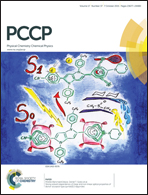Nucleobases tagged to gold nanoclusters cause a mechanistic crossover in the oxidation of CO†
Abstract
DNA is considered as a programmable building block for the assembly of nanomaterials that play a significant role in modern day nanotechnology and catalysis. In this work, density functional theory (DFT) is used to explore the possible application of complexes of DNA bases (adenine (A), thymine (T), guanine (G), and cytosine (C)) and their size expanded (x) counterparts with Au3 gold clusters as a model catalyst system for oxidation of CO to CO2. We investigate how the catalytic potential of the Au3 cluster is modulated on being tagged with the nuclebases. The CO oxidation can take place via the ER or the LH mechanism. On a pristine cluster, the LH pathway is thermodynamically favored. However, the CO oxidation reaction on the nucleobase tagged gold cluster is found to be more facile following the ER mechanism, with a significant reduction in the barrier height. The reduction in barrier height is attributed to the formation of additional hydrogen bonds between O2 and the polar sites of the attached base in the transition state. This indicates an interesting implication of tagging the cluster to a nucleobase resulting in a mechanistic crossover which is responsible for making nucleobase tagged gold clusters a better catalyst in comparison to pristine Au3 clusters. Our results indicate that nucleobase–gold cluster complexes open new avenues as efficient catalytic models having a wider range of technological applications.


 Please wait while we load your content...
Please wait while we load your content...